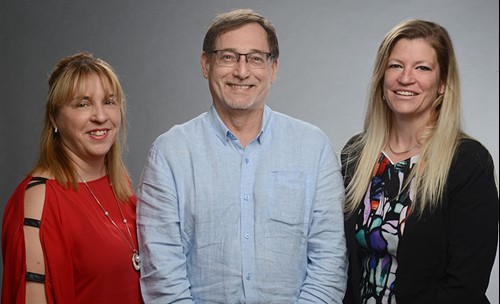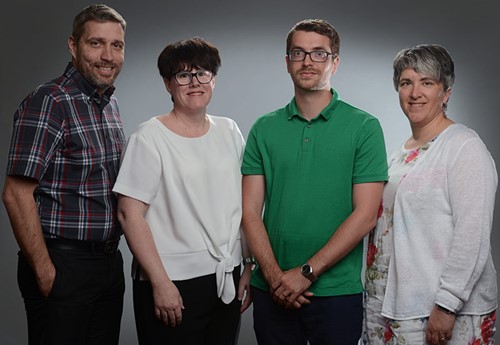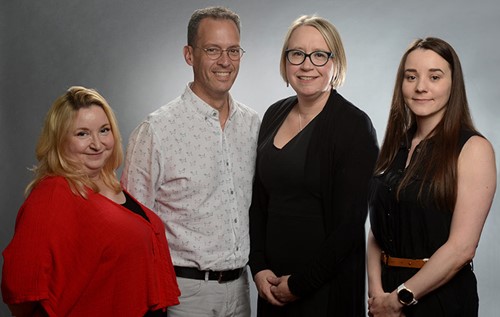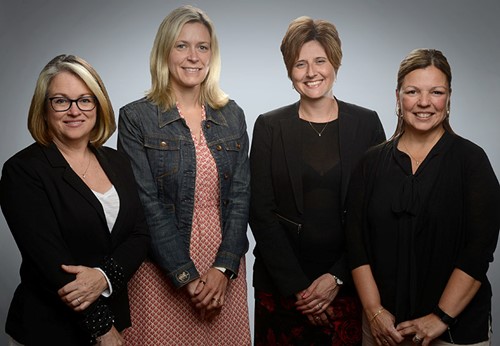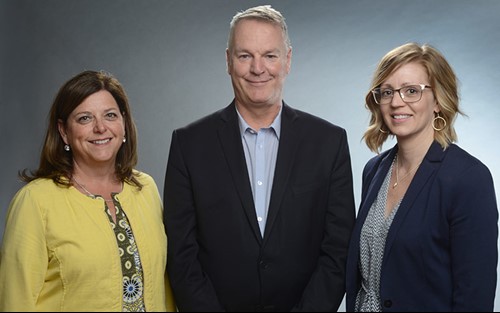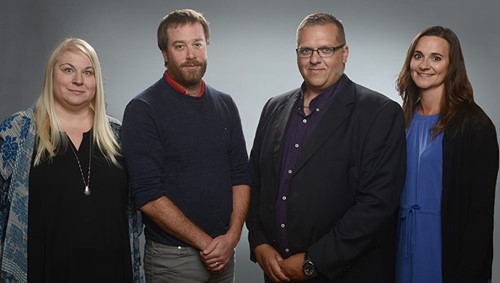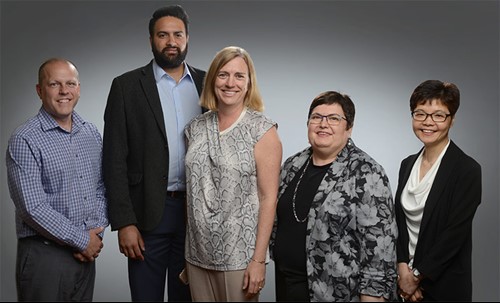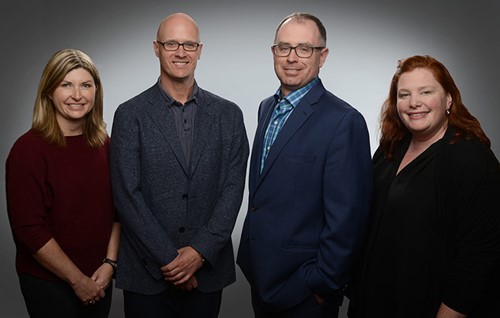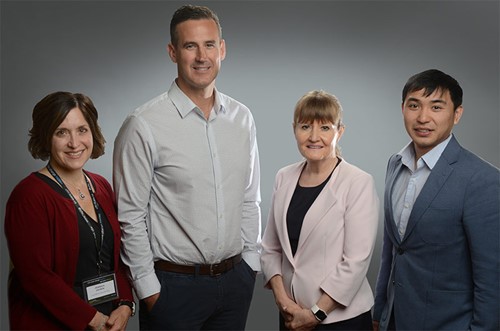2019 EXTRA Improvement Projects
Centre intégré de santé et de services sociaux de la Montérégie-Est (QC) / Association Québécoise en retraitement des dispositifs médicaux (QC)
- Dr. Richard Marchand, Microbiologiste et infectiologue
- Mme Mélissa Giroux, Chef de la prévention et du contrôle des infections
- Mme Sylvie Paradis, Coordonnatrice URDM et endoscopie, répondante URDM pour Montérégie-Est
Mapping Out Medical Device Reprocessing Risks
Incidents and accidents related to the reprocessing of medical devices are underreported at Centre Intégré de Santé et de Services Sociaux (CISSS) de le Montérégie-Est facilities. This improvement project aims to improve monitoring procedures relating to medical device reprocessing. The project has three goals:
- Reduce annual incidents and accidents related to medical device reprocessing by 25% at the Pierre-Boucher Hospital (CISSS Montérégie-Est facility);
- Increase incident and accident reporting by 25%;
- Ensure staff receive training on the importance of reporting incidents and accidents.
Centre intégré universitaire de santé et de services sociaux de la Capitale-Nationale (QC)
- Mme Caroline White, Coordonnatrice des services spécifiques
- M. Louis-Philippe Emond, Chef de service
- M. Patrick Corriveau, Directeur adjoint de la protection de la jeunesse
- Mme Marie-Josée Santerre, Chef de programme mandats transversaux
Acting Early and Jointly in Cases of Neglect
This improvement project aims to reduce reports of neglect by March 2020 and enhance coordination among partners who share these clients. The team will develop a service continuum aimed at early prevention and intervention in cases of neglect. This continuum will include universal measures as well as specific and specialized services.
This approach will consolidate a screening pathway for vulnerable pregnant women and families in order to provide them with individualized services. It will also strengthen the SIPPE (Services intégrés en périnatalité et pour la petite enfance) prevention program’s implementation, with a view to maximizing the potential health and well-being of mothers and fathers. The program will promote optimal development in unborn babies and young children (ages 0-5) in vulnerable situations by:
- Monitoring physical and mental health in pregnant women;
- Developing and strengthening parent-child bonds;
- Stimulating cognitive, emotional, social and psychomotor development in children;
- Improving home safety;
- Fostering the development of new and existing parenting skills;
- Including the birth and development of children in a successful life plan for parents.
The service continuum between the SIPPE and neglect programs will help address service gaps and strengthen professionals’ knowledge and skills in detecting and acting in cases of neglect.
Centre intégré universitaire de santé et de services sociaux du Centre-sud-de-l'île-de-Montreal (QC)
- Mme Isabelle Savard, Directrice adjointe des services professionnels-Volet affaires médicales
- Mme Kristine Vitez, Directrice adjointe des services multidisciplinaires-Volet opérations
- M. Bobby Paré, Coordonnateur Clinico-Admimistratif conitnuum de chirurgie
- Dre Amélie Foucault, Chef du service de chirurgie générale de l’Hôpital Notre-Dame
Embedding Mindfulness in the Operating Room
This improvement project aims to improve the well-being of staff, physicians and operating room managers at the Notre-Dame Hospital. In a second phase of the project, the team’s goal will be to improve patient experience of care in the operating room by reducing their perception of pain and improving anxiety management in participating patients. Physicians and operating room managers will be:
- Trained in mindfulness with continuous practice techniques and;
- Provided with guided meditation vignettes for patients undergoing surgery at Notre-Dame Hospital.
In order to achieve this, operating room professionals and managers will be trained in mindfulness, and mindfulness techniques will be embedded into the surgery process. In addition, patients undergoing surgery at Notre-Dame will have access to guided meditation capsules upon pre-admission.
Centre hospitalier universitaire du Québec - Université Laval (QC)
- Mme Caroline Imbeau, Directrice générale adjointe soutien et administration
- Mme Caroline Fortin, Coordonnatrice service de néphrologie
- Mme Isabelle Vézina, Directrice adjointe des soins infirmiers, volets pratiques professionnelles, enseignement et recherche
- Mme Marie-Hélène Boulanger, Directrice adjointe de la logistique
Improving Access to Nursing Care through Hospital Logistics
Decision-makers and care and support teams are changing their mindset about current workforce conditions in hospitals. This improvement team wants to positively impact the quality and safety of patient care and optimize patients’ experience of care. Tasks with a lower added-value currently performed by nursing staff will be shifted to a logistics team, allowing for more fulsome and consistent care throughout the patient’s journey. Specialized healthcare staff workflows will change in order to increase the time they spend with patients.
This will create interdisciplinary workflow models for all teams involved in patient care, both at the clinical and logistical levels. Roles, responsibilities, work schedules and job descriptions will be reviewed according to patient needs. Tasks will be assigned for every 24-hour period and assessed in order to optimize the presence of clinical staff. The Improvement Team will review processes and workflows with a view to optimizing and streamlining them. This should eliminate a large number of non-value-added tasks for all staff and allow them to focus on their primary mission and, ultimately, improve the quality of care.
Centre intégré de santé et de services sociaux de la Montérégie-Ouest (QC)
- Mme Marie-Eve Bernard, Adjointe au président-directeur général
- Mme Linda Haworth, Directrice adjointe des programmes jeunesse et activités de santé publique
- M. Jean-Marc Ricard, Directeur des programmes déficiences
Labour issues: Barriers to the Rehabilitation of Residents in RACs (residential centres with conituous care)
Labour issues in the health and social services network make it difficult to achieve the Rehabilitation Program’s goals for residents in RACs (group homes with continuing care) who have a behavioural disorder or a serious behavioural disorder (BD/SBD). These problems have become more pronounced in recent years. Some examples of these issues include shortages of qualified personnel, absenteeism, staff turnover, work schedules and inadequate training of staff to support these residents.
By the end of the project, we expect the chosen solutions to address labour issues in the targeted RACs to improve three key components of patient care plans by 20%:
- Rate of patients with a behavioural disorder/serious behavioural disorder (BD/SBD) who underwent a multimodal analysis;1
- Rate of patients with a BD/SBD who are closely monitored post-intervention;
- Rate of patients with a BD/SBD who currently have a rehabilitation/treatment goal.
Building on scientific evidence and client experiences, the project aims to identify best practices for clinical improvements, human resources management and promoting a healthy work environment. Based on these findings, the team will work closely with a RAC’s stakeholders who are experiencing labour challenges. Our goal is to identify the best strategies to meet the needs of this program's clients and mitigate the RAC’s workforce challenges. Clients and families of this RAC will work closely with the project team.
(1) A Multimodal Analysis and Intervention (MMAI) combines the principles of positive approaches to care and individual quality of life and, based on developed causal and overall assumptions, sets in motion targeted intervention strategies whose effectiveness and relevance can be assessed through monitoring (Service québécois d’expertise en troubles graves du comportement).
Health and Social Services, Government of Yukon (YK) / Justice Department, Government of Yukon (YK)
- Ms. Mary Vanstone, Director, Mental Wellness and Substance Use, Health and Social Services
- Mr. Cameron Grandy, Clinical Manager Mental Wellness Substances Use, Health and Social Services
- Mr. Jayme Curtis, A/Director Corrections, Department of Justice
- Ms. Sarah Gau, Manager, Health Services, Department of Justice
Creation of the forensic mental wellness therapeutic services program
Research suggests that developing targeted programs to address the mental wellness and substance use of criminal justice clients can reduce re-contact with the system. This improvement project aims to address the structural problems that create barriers for justice clients accessing mental health and substance use treatment. We will create a team, including a Clinical Manager and three masters level clinical counsellors dedicated to forensic clients, which include incarcerated and community clients. The team will have an understanding of forensic risk, forensic treatment and a strong background in mental health and substance use treatment.
Effective assessment and treatment requires partnerships with many, including the courts, counsellors/psychologists, corrections staff, policy makers, and Yukon First Nations. Inmates will receive access to assessment and/or treatment even if they are in the centre for a short time, including continuity of care when transitioning from the centre back into the community. The team will liaise with partners to deliver the proper treatment and support plans for the client. The team will develop and deliver appropriate treatment to address the underlying issues contributing to criminal behaviour.
BC Cancer (BC)
- Ms. Bernice Budz, VP, Patient Experience and Interprofessional Practice
- Dr. Caroline Lohrisch, Medical Oncology Department Head, Vancouver Centre
- Mr. John Larmet, Senior Regional Director, Kelowna Centre
- Ms. Cecilia Li, Provincial Director, Professional Practice Nursing
- Mr. Ranjit Mattu, Coordinator, Planning & System Development
Advanced specialized oncology access: transforming the interdisciplinary patient family centered approach
This improvement project aims to minimize delays, reduced duplication of historical information patients provide to healthcare professionals, foster the creation of care plans, and reduce the number of patient visits before definitive therapy begins by creating an interdisciplinary consult service that focuses on the first oncology appointment. The model will start with breast cancer referrals and can be generalized to other tumor sites by embedding the specific disciplines and services unique to each population.
A nurse will meet with the patient at the first appointment to ensure the provider has the information they need and to help patient with any anxiety he/she may be feeling from waiting. The patient will also receive a phone call following the appointment to ensure he/she understands the information provided, including instructions for prescribed medication. For patients who are receiving radiation treatment, the service would aim to expedite radiation oncology consultation. Ultimately our goal is to reduce wait times for consultation, while also reducing time until treatment begins.
A physician rotation of coverage will eliminate the cancellation of appointments that occur when a clinician is away. This improvement project will allow the team to align specialist oncology clinics to prevent blacked out schedules and ensure continuity of care.
Nova Scotia Health Authority (NS)
- Mr. Matthew Murphy, Director, Performance, Analytics & Accountability
- Mr. Steven Carrigan, Manager - Performance and Analytics
- Ms. Tanya Penney, Sr Director, Emergency Program of Care and Sr Director, Critical Care Program
- Mr. Andrew Nemirovsky, Sr Director and CIO
Predicting the Patient Journey: Volume & Flow Forecasting
A key objective of Nova Scotia Health Authority is efficiency in care. How can we safely maximize the patients seen and cared for with available resources so that we meet the care needs of Nova Scotians? This improvement project is focused on a greater understanding of patient flow to forecast patient volumes and bottlenecks at multiple points along the patient journey. An applied analytics approach will be used to forecast patient flow in emergency and inpatient services to better understand queues and constraints.
The project will focus on understanding the link between service demand, individual patient care needs, provider requirements and system level factors and how they intersect to form a patient flow journey. This improvement project aims to support decision-making that provides consistent, sustainable, high-quality person-centred care to Nova Scotians.
Nova Scotia Health Authority (NS)
- Mr. Lewis Bedford, Director, Trauma
- Dr. Robert Green, Senior Medical Director, Trauma Program
- Mrs. Cynthia Isenor, Health Services Director, Central Zone Critical Care, Policy and Planning, NSHA Critical Care Program
- Mrs. Angela Stairs, Director, Rehabilitation Services, Eastern Zone
'Get Moving': Mobility as an integrated approach to improve outcomes
Implementing an early mobilization program in the Intensive Care Unit (ICU) is safe and can improve important patient outcomes.
In 2012, the inter-professional team at the Queen Elizabeth II Health Sciences Centre developed an early mobilization program for all ICU patients in their units. Dedicated services were put in place, and mobilization was promoted as an expected standard of care. The project found a reduction in trauma patient ICU mortality and in overall hospital mortality.
Based on the outcomes and lessons learned through the experience at the two tertiary sites, this improvement team will develop the approach, plan and tools necessary to enable the dissemination of this practice change to pilot Regional and Community ICUs and to additional ICU and non-ICU patient care locations across Nova Scotia and beyond.
This improvement project will promote best-practice initiatives, including appropriate sedation and pain control.
British Columbia Emergency Health Services (BC)
- Mrs. Suzanne Fuller Blamey, Corporate Director, Quality and Safety
- Ms. Jessica Jaiven, Director, Quality, Patient Safety and Accreditation
- Dr. Wilson Wan, Medical Director, Fraser Health and Acting Medical Director, Patient Care Communications and Planning
- Mr. Ole Olsen, Paramedic Practice Leader
Improving Trauma Patient Outcomes with Advanced Province Wide EMS Triage
The provincial Pre-hospital Triage and Transport Guidelines standardized the definition of major trauma in adult and pediatric patients in British Columbia. In addition, it established a current list of Lead Trauma Hospitals (LTH), designated by each Health Authority to accept and manage major trauma patients within each region of the province.
Regional efforts to improve short- and long-term outcomes after severe trauma will be focused on the optimization of access to pre-hospital care. This project will first look at implementing the guideline within two trauma designated hospitals in the Fraser Region, as the testing site, before expanding it to the rest of the province. The focus will address four main domains:
- Reviewing current and proposed changes to practices in the Trauma Designated ERs;
- Communication and knowledge translation;
- Improving documentation practices;
- Measuring clinical performance indicators linked to patient outcomes.
The team will test different change ideas to establish a comprehensive multipronged communication and knowledge translation strategy that ensures successful implementation of the guideline in the biggest urban area in BC. The approach will build on this and focus on two components: online communication and face-to-face learning support.
In addition, with the recent implementation of an electronic health record platform (SIREN). Using SIREN, paramedics will be asked if a patient meets major trauma criteria on every encounter. It also allows the team to develop a unique documentation form for major trauma with specific data fields that are meaningful for evaluation. Fields can be made mandatory with specific selections for answers rather than free text, improving documentation rate and reducing variability of the responses which has well documented success in the patient safety and health quality literature.
The team envisions using the learnings from this project as an opportunity to rollout future changes in the organization.
Michael Garron Hospital (ON)/ VHA Home Health Care (ON)/ Woodgreen Community Services (ON)
- Ms. Ashnoor Rahim, Vice President, Community Care, WoodGreen Community Services
- Mr. Courtney Bean, Director, Client Services, VHA Home HealthCare
- Mrs. Sandra Dickau, Director Medicine & Critical Care, Michael Garron Hospital
- Dr. Christopher N.C. Smith, Staff Physician, General Internal Medicine, Michael Garron Hospital
- Mr. Mark Fam, VP, Clinical Programs, Michael Garron Hospital
Home 2day: Acute Care of Admitted COPD Patients at Home
Chronic Obstructive Pulmonary Disease (COPD) admissions are a significant burden to hospitals. Michael Garron Hospital discharges 450 COPD patients annually with an average length of stay of seven days. After a brief acute phase (1-2 days), patients under usual care remain in hospital to recover and are at risk for hospital acquired infections, caregivers are burdened with travel, and care delivery is inefficient due to low acuity.
Home 2day identifies low-risk medical patients who can safely receive acute treatment in their own homes with appropriate supports. In-home and virtual care is provided for up to one week by an interdisciplinary team from hospital and home care partners. Home 2day is expected to be as safe as regular care while being more patient-centred, less costly per case, and freeing up specialized resources to care for more acute patients (Echevarria, 2018).
This improvement project relies on evidence-based tools to identify low-risk patients and a standardized transition pathway to deliver wraparound care, education, and navigation. The model consists of in-home care driven by the needs of the patient, physiological monitoring, virtual consultation, case management, 24/7 emergency contact number, and access to a rapid response clinic. At discharge from Home 2day, patients are linked to traditional home care supports.
By defining and refining a standardized care transition pathway, the integrated model clarifies roles of hospital, home and community-based teams and helps to determine critical conditions that support transition to home. The model will expand to other conditions with similar resource utilization patterns such as congestive heart failure, pneumonia, and cirrhosis.
